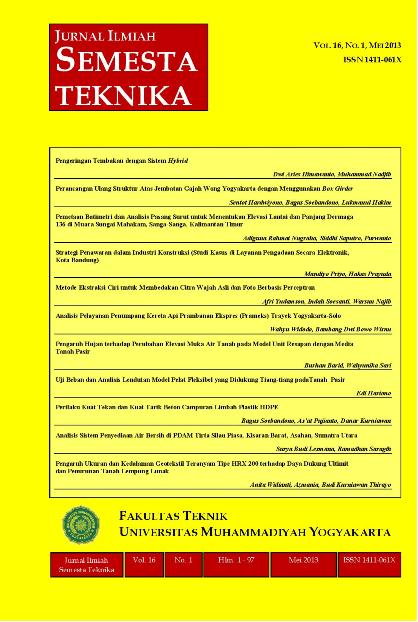Metode Ekstraksi Ciri untuk Membedakan Citra Wajah Asli dan Foto Berbasis Perceptron
DOI:
https://doi.org/10.18196/st.v16i1.431Abstract
Face is one of media for human identification. Previous studies aimed at identifying human face were for a two-dimensional images. Thus, fraud may occur when providing input in two-dimensional face images (photos). This study aims to distinguish the original three-dimensional face image with two-dimensional face image. Feature extraction based on facial geometry principles (Incomplete sentence, subject only, do not know what the authors mean). Face images (both the original and the photos) were captured at deviated angle, to the left and to the right. Each image is then sliced for each face components (eyes and nose) and sought the position of the center point of each component. Comparison between the value of the right eye-nose projection vector to the left-right eye vector and the value of the left-right eye vector become the characteristics of each image. The perceptron method was used for the classifiers. The result, the software can distinguish the original three-dimensional and two-dimensional face image with an error of 8.33% of the 24 tested images. Error occurred for some samples that show big round nose.Downloads
Published
2015-11-27
How to Cite
Warsun Najib, A. Y. , I. S. (2015). Metode Ekstraksi Ciri untuk Membedakan Citra Wajah Asli dan Foto Berbasis Perceptron. Semesta Teknika, 16(1). https://doi.org/10.18196/st.v16i1.431
Issue
Section
Articles
License
Semesta Teknika is licensed under a Creative Commons Attribution 4.0 International License.
Authors who publish with this journal agree to the following terms:
- Authors retain copyright and grant the journal right of first publication with the work simultaneously licensed under a Creative Commons Attribution License that allows others to share the work with an acknowledgement of the work's authorship and initial publication in this journal.
- Authors are able to enter into separate, additional contractual arrangements for the non-exclusive distribution of the journal's published version of the work (e.g., post it to an institutional repository or publish it in a book), with an acknowledgement of its initial publication in this journal.
- Authors are permitted and encouraged to post their work online (e.g., in institutional repositories or on their website) prior to and during the submission process, as it can lead to productive exchanges, as well as earlier and greater citation of published work (See The Effect of Open Access).









